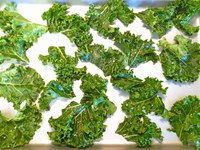Prairie Fare: Feast Your Eyes on Kale
(Click an image below to view a high-resolution image that can be downloaded)
By Julie Garden-Robinson, Food and Nutrition Specialist
NDSU Extension Service
“I really need to clean the windshield. It’s really dirty,” my husband commented one day about 15 years ago.
I was looking straight ahead through the crystal-clear windshield on the passenger side of the vehicle. I strained my neck to peek over at his side. It looked OK to me.
The next morning we were out driving again, and he said, “It’s really hazy outside. I wonder when this fog is going to clear.”
“There is no fog. I think you need new glasses,” I replied. I also was thinking I should be the one driving.
“Let’s set up an appointment for you to see an eye doctor right away,” I added.
After his appointment, he walked into our kitchen and said, “You’re not going to believe this.”
I grabbed a chair and sat down without prompting.
“I have cataracts and they want to operate as soon as possible,” he said.
I was glad I was sitting down.
“I know you’re older than I am, but just how old are you, anyway?” I asked, only half joking.
Turns out, you can have cataracts at almost any age. The nurses referred to him as their pediatric case after his surgery. Fortunately, he has had no further vision issues.
June is designated as Cataract Awareness Month, so it’s a good time to pay attention to your eyes. Untreated cataracts are one of the leading causes of blindness.
A cataract is a clouding of the lens of the eye. A normal lens focuses light on the retina to produce a clear image. Family history, diabetes, smoking, drinking alcohol and prolonged exposure to sunlight are risk factors for cataracts.
While we often associate cataracts with advancing age, surprisingly, some babies are born with cataracts. Many adults in their 40s and 50s are diagnosed with cataracts.
The National Eye Institute of the National Institutes of Health recommends a comprehensive dilated eye exam, which can help detect cataracts as well as age-related macular degeneration and diabetic eye disease.
Because exposure to sunlight is linked with cataract development, we all should be protecting our eyes by wearing high-quality sunglasses that block out 99 to 100 percent of UV-A and UV-B radiation. Some sunglasses on the market can do more harm than good, so be sure to do your homework.
Don’t forget that proper nutrition affects all areas of health, including your eye health. Some of the best foods for our eyes are colorful antioxidant-rich fruits and vegetables, particularly dark green leafy vegetables (especially kale) and dark orange and gold vegetables. Other eye-healthy foods include omega-3-rich salmon and other fatty fish and egg yolks.
Kale is a member of the Brassica family that includes broccoli and cabbage. This nutrition powerhouse is loaded with phytochemicals, which are natural cancer-fighting compounds, plus vitamins A, C and K and several minerals, including iron.
However, if you are on a blood-thinning drug such as Coumadin, you may be advised to go easy on kale because of its vitamin K content. Check with your doctor or pharmacist.
If you have a garden, add a row of kale, or look for it at a grocery store. Kale can be used as a substitute for spinach in salads. You can sauté kale with a bit of oil or add it to pasta dishes for color and extra nutrition.
Kale chips are a trendy new snack item available in grocery stores in some parts of the country. You might find kale chips in a variety of flavors, ranging from zesty to cocoa-flavored to hot and spicy.
Here’s a recipe from my colleague Alice Henneman, Extension educator at the University of Nebraska-Lincoln Extension Service. Try these crisp baked kale chips as a snack or side dish to add nutrition and color to your plate. Try them with an egg salad sandwich to double up on eye-healthy nutrients. Eggs are a good source of lutein, another eye-healthy natural pigment.
Baked Kale Chips
1 bunch kale
2 tsp. olive oil (approximately)
Preheat the oven to 200 degrees F. Lightly spray two large baking sheets with vegetable oil cooking spray. Wash and thoroughly dry the kale. A salad spinner works well, followed by patting the kale dry with paper towels or a dish towel. Cut with kitchen shears or tear leaves from stems and thick center rib in middle of leaves, then tear into large sections. Toss with 1 teaspoon oil in a large bowl. You may wish to use your fingers to distribute the oil on the leaves. Use slightly more oil if needed.
Place in a single layer on baking sheets; use separate oven shelves if needed. Bake about 20 minutes. Then remove the baking sheets from the oven, turn kale chips over and switch shelves if the pans were placed on separate shelves. Check after an additional 10 minutes to determine if they are evenly crisp. Continue baking if needed. The time may vary with your oven. For future reference, record the time that works for you. Let chips cool slightly on a baking sheet placed on a cooling rack. Finally, transfer to a bowl and sprinkle lightly with salt, grated Parmesan cheese or your favorite spice if desired.
A nutritional analysis of kale chips is not readily available, but 1 cup of chopped kale has about 35 calories, 1.3 grams (g) of fiber and 7 g of carbohydrate. The sodium value in your chips will vary depending on your choice of seasonings.
(Julie Garden-Robinson, Ph.D., R.D., L.R.D., is a North Dakota State University Extension Service food and nutrition specialist and associate professor in the Department of Health, Nutrition and Exercise Sciences.)
NDSU Agriculture Communication – June 8, 2012
| Source: | Julie Garden-Robinson, (701) 231-7187, julie.garden-robinson@ndsu.edu |
|---|---|
| Editor: | Rich Mattern, (701) 231-6136, richard.mattern@ndsu.edu |




